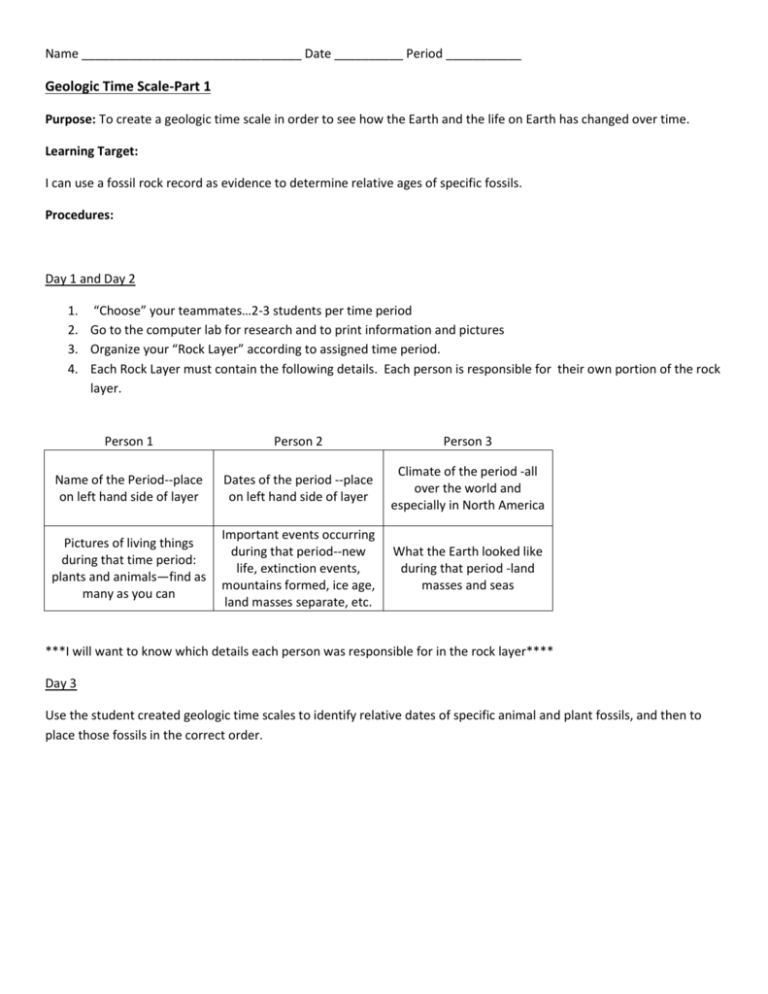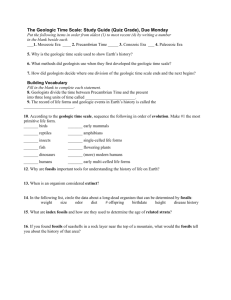Lab parts 1 and 2
advertisement

Name ________________________________ Date __________ Period ___________ Geologic Time Scale-Part 1 Purpose: To create a geologic time scale in order to see how the Earth and the life on Earth has changed over time. Learning Target: I can use a fossil rock record as evidence to determine relative ages of specific fossils. Procedures: Day 1 and Day 2 1. “Choose” your teammates…2-3 students per time period 2. Go to the computer lab for research and to print information and pictures 3. Organize your “Rock Layer” according to assigned time period. 4. Each Rock Layer must contain the following details. Each person is responsible for their own portion of the rock layer. Person 1 Person 2 Person 3 Name of the Period--place on left hand side of layer Dates of the period --place on left hand side of layer Climate of the period -all over the world and especially in North America Pictures of living things during that time period: plants and animals—find as many as you can Important events occurring during that period--new life, extinction events, mountains formed, ice age, land masses separate, etc. What the Earth looked like during that period -land masses and seas ***I will want to know which details each person was responsible for in the rock layer**** Day 3 Use the student created geologic time scales to identify relative dates of specific animal and plant fossils, and then to place those fossils in the correct order. Name _________________________________ Date _____________ Period _________________ Geologic Time Scale Lab - Part 2 Purpose: To create a geologic time scale in order to see how the Earth and the life on Earth has changed over time. Learning Target: I can use a fossil rock record as evidence to determine relative ages of specific fossils. Procedures: 1. Part A: Use the colored rock layers to identify the correct Period of as many fossils as you can in the five minute time frame that is allotted. (Chart A) You must find evidence of the fossils in at least three time periods to be considered valid. Fossil 1 Tyrannosurus Rex 2 Conifers 3 Modern Humans 4 Cyads 5 Elephants 6 Arachnids (spiders) 7 Bony fish 8 Red/green Algae 9 Dimetrodon 10 Wooly Mammoth 11 Crinoids 12 Apatosaurus 13 Jawed Fishes First Flowering Plants 14 15 Dragonfly 16 Coelophysis 17 Grass 18 Trilobites 19 Diplodocus 20 Sharks 21 Archaeopteryx 22 Primitive Horses 23 Mollusks 24 Stegosaurus 25 Brachipods Yellow Orange White Brown Purple Part 2: Chart B Mesozoic Cenozoic Put the 25 fossils in their correct locations of the geologic time frame. Remember…you must have found it in at least three rock sections in order for it to be valid. Quarternary Tertiary Cretceous Jurassic Triassic Permian Paleozoic Carboniferous Devonian Silurian Ordovician Cambrian Precambrian Formation of the atmosphere, the oceans, and the continents Part C: Identify which Era the following events occurred. C= Cenozoic M= Mesozoic P=Paleozoic _____1. Reptiles become the dominant life form _____2. First vertebrates appear _____3. Whales and dolphins appear _____4. First appearance of grass eating mammals _____5. Animals and plants begin to live on land _____6. First mammals appear on Earth _____7. Giant Forests develop _____8. Continental glaciers melt _____9. Sea level rises _____10. Reptiles appear Part D: Match the correct time period with the event _____ 20,000 years ago A. Continental glaciers retreat _____ 3.5 million years ago B. First Fish appear _____ 6.5 million years ago C. Oldest fossils form _____ 260 million years ago D. Human ancestors appear _____ 400 million years ago E. Explosion of invertebrates occur _____ 544 million years ago F. Dinosaur become extinct _____ 3.5 billion years ago G. Pangaea forms Conclusion Questions 1. Which organisms or parts of organisms typically become fossils? 2. How do you know which fossils in a rock cycle are the oldest or the youngest? 3. Suppose you found a fossil of a clamshell. What can you conclude about the organism that once lived? 4. A wooly mammoth is a relative of the elephant. Why do you think that the wooly mammoth had all the long hair, while elephants today have barely any hair on them? 5. How are the fossils at the top of the rock record different from the fossils found at the bottom? 6. How does the fossil record provide evidence for evolution?








